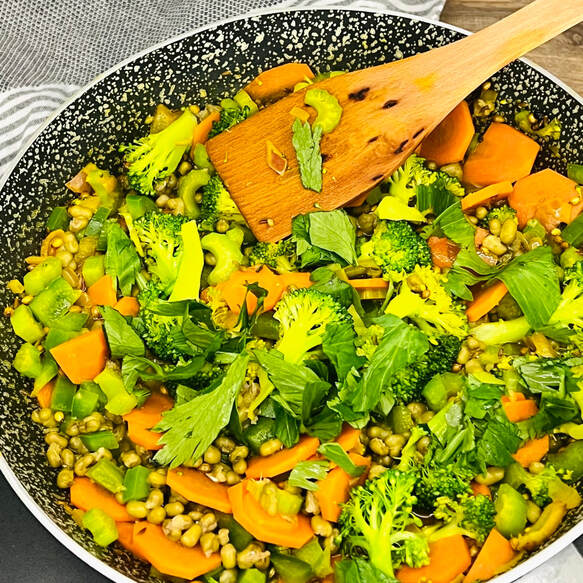Information



Learn about the importance of cooking consciously with these 3 Ayurvedic principles when cooking food.
Ayurvedic cooking focuses on making well balanced and nourishing meals for both the body and the mind. Ideally we would know our primary dosha (body constitution) so that we can understand what foods are most compatible and suitable for our body type or if there is an imbalance of the doshas, to help minimise this. Actually, the main idea is to create simple/easy to digest, wholesome foods that ultimately help our body receive the nutrients it needs to function at a healthy level. This also applies for the mind.
Let’s look at some of the key principles to take in consideration in Ayurvedic cooking.

When you enter the kitchen of somebody who is cooking with an Ayurvedic approach, for sure you’ll be able to smell a delicious aroma of spices. Even if the meal is super simple, it will seem they are creating a culinary masterpiece because the smell is so rich and abundant. These spices are not “spicy condiments”, but spices in the form of cooking herbs. There are so many different ones and knowing your Ayurvedic predominant dosha can help you choose which spices to use mainly. However, there are some Tridoshic ones, meaning they balance all three doshas (when used in moderation) and can always be used. These are: cumin, ginger and turmeric (there are some others also).
We use spices not only for the delicious taste they give to a dish, but also for their qualities. They have the power to transform a food. For example, when cooking a dish which has warming qualities, we can include spices which are cooling (for example coriander seeds or mint) to balance the quality of the dish and make it suitable for Pita dosha, which prefers cooling quality. The same can be done to transform a cooling dish to a warming quality by using the appropriate heating spices to make it more suitable for Vata and Kapha dosha, which prefer warmth in the food. Another example is when cooking a heavier quality dish, we can use spices that aid digestion and make it more light, such as cumin, turmeric and ginger. Or we can even help to purify a specific food by using turmeric, which helps to cleanse the energy of the food.
Food in Ayurveda is considered like medicine. In both yoga philosophy and Ayurveda, we learn that food is a great source of prana (life force). Good, wholesome food has plenty of prana. Therefore food has energy. It is advised to always cook with an intention of gratitude and love, especially so when we cook for others. Some Ayurvedic practitioners even chant specific mantras during the making of the meal. It is like blessing the food and being grateful for it.
One key Ayurvedic principle is to never cook or eat when angry, annoyed, sad, frustrated, irritated etc. It is also best not to cook in a rush and handling the food poorly, such as quickly throwing the food in a pot to cook. Because this energy will be transferred to the food and when we eat it, we ingest this sort of energy. These are all practices that support good digestion and maintaining the good quality of the food. Connecting to the food’s energy is part of the making and taking of it, as well as digesting it for all its sattvic qualities.

Finally, and most obviously, for food to support our overall optimum functioning and health, it should be wholesome food. In yoga and Ayurveda, we call this sattvic food, which means pure and wholesome. This includes everything that came directly from the earth, like vegetables, fruits, nuts, grains and ideally organic. Vegetarian diet is advised because of the principle of ahimsa (non-violence) and because this food is not as heavy as non-vegetarian food. Although in some Ayurvedic health treatments for curing a disease, some specific meat is needed; I am also not suggesting you become vegetarian because this is a personal preference for all and only you know what best suits your body and what it needs.
It is also important to note that in Ayurveda, it is always considered better to cook the foods, than to eat them raw. This is because raw food is more difficult to digest, therefore supporting agni (the digestive fire). Another reason is because raw food is cooling in property and this puts down the agni which makes it harder to digest and creates imbalances. But this does not mean that raw food cannot be taken. It can be done with using spices to help it digest better, or some good quality non-refined oil to lubricate the food, making it easier to take. But as a best practice, especially for those with Vata and Kapha dosha, should try (as much as possible) to eat cooked food.
We don’t need fancy foods or ingredients, to cook Ayurvedicly. We just need to learn to cook with lots of flavour (using spices), prioritise wholesome foods and to cook with love, which means to enjoy and appreciate the food.
*I’d like to add that another very important aspect when cooking with an Ayurvedic approach is the taste. Ayurveda presents 6 different tastes which every meal should have. I will discuss these in a different post.